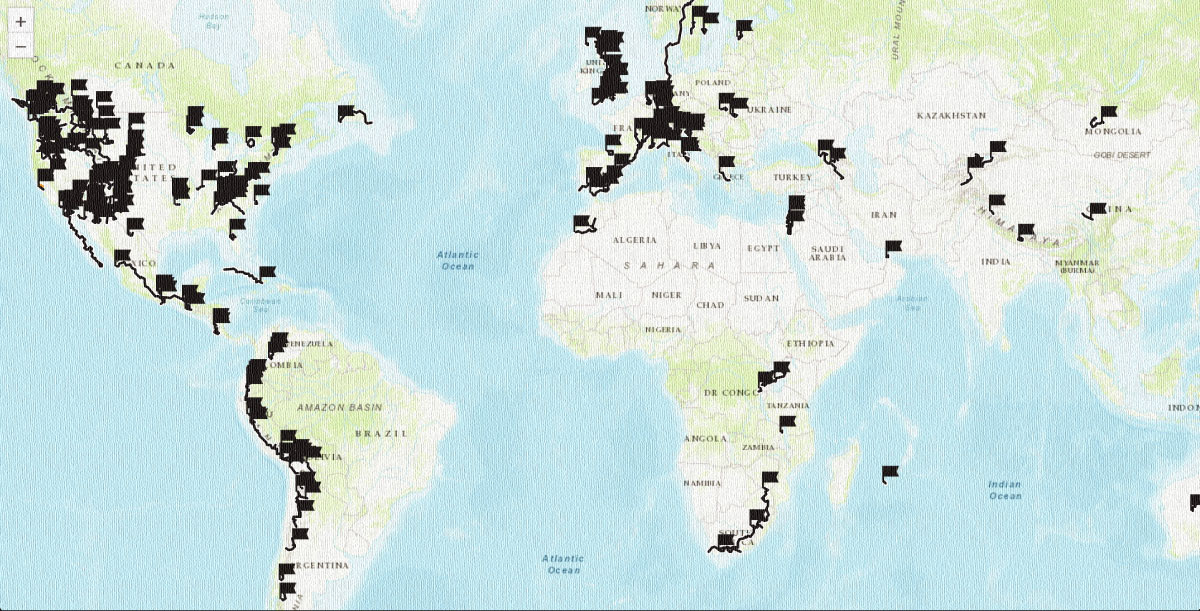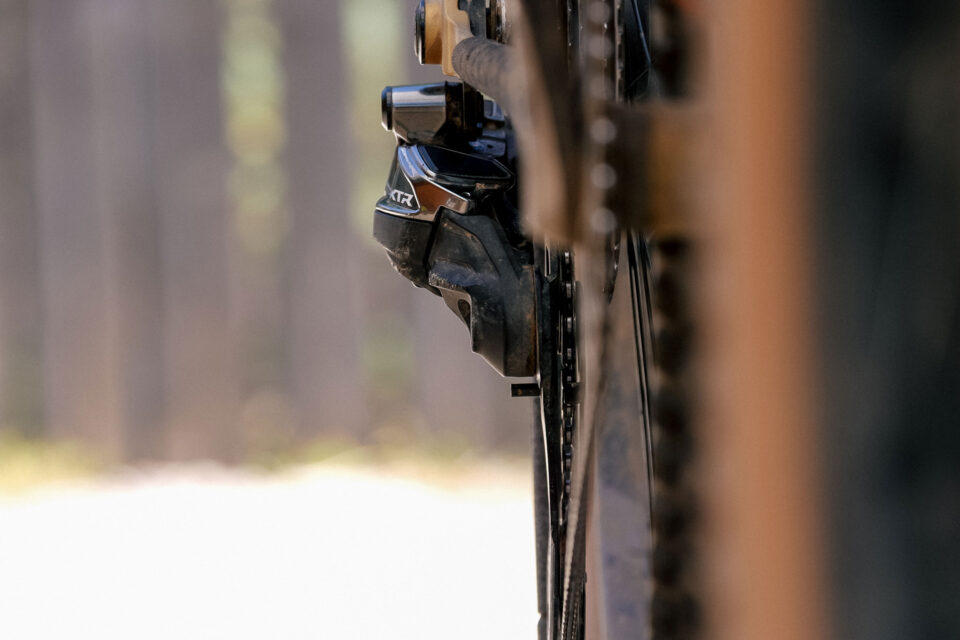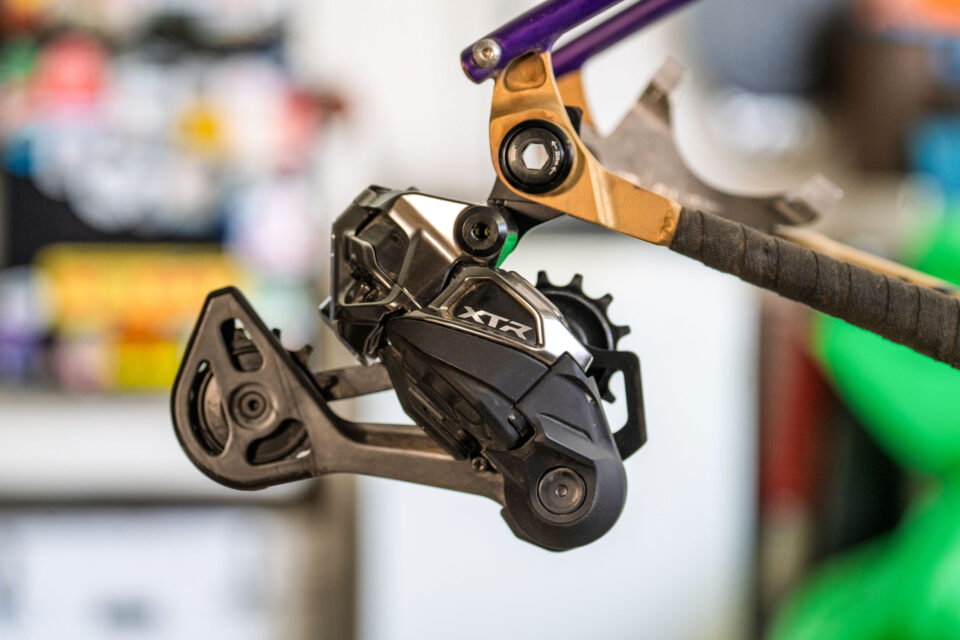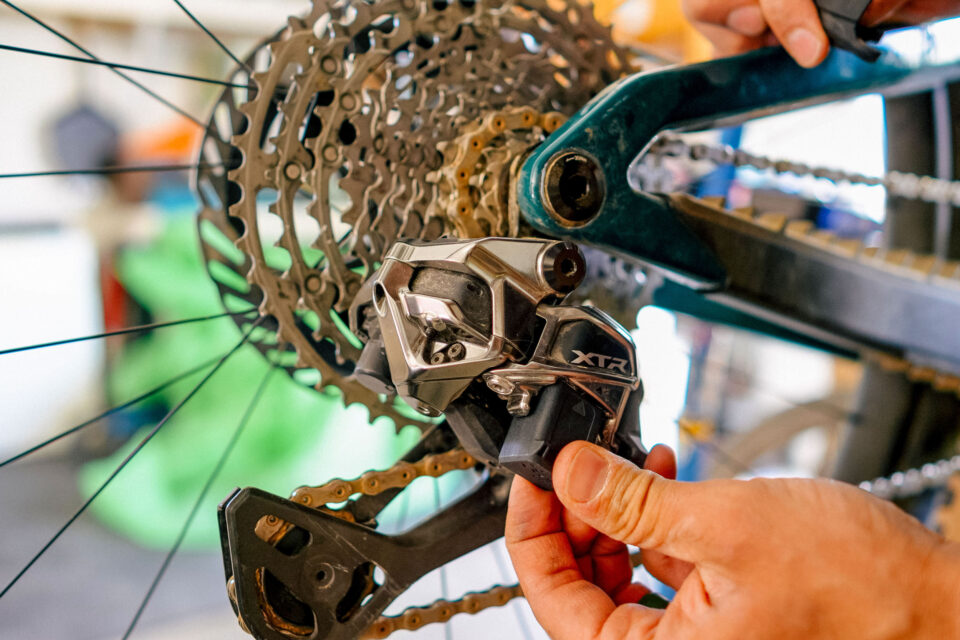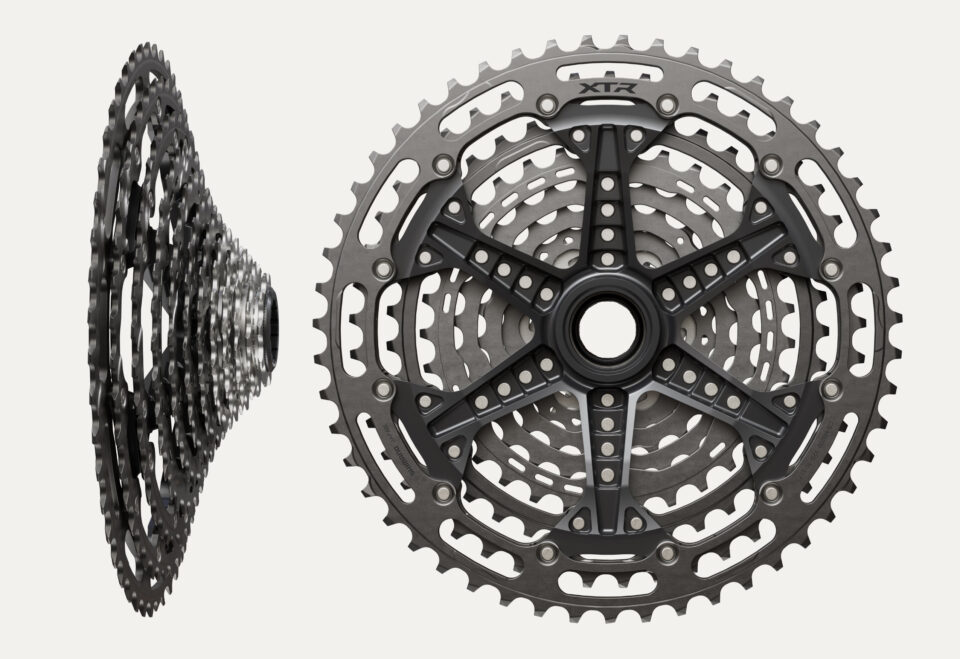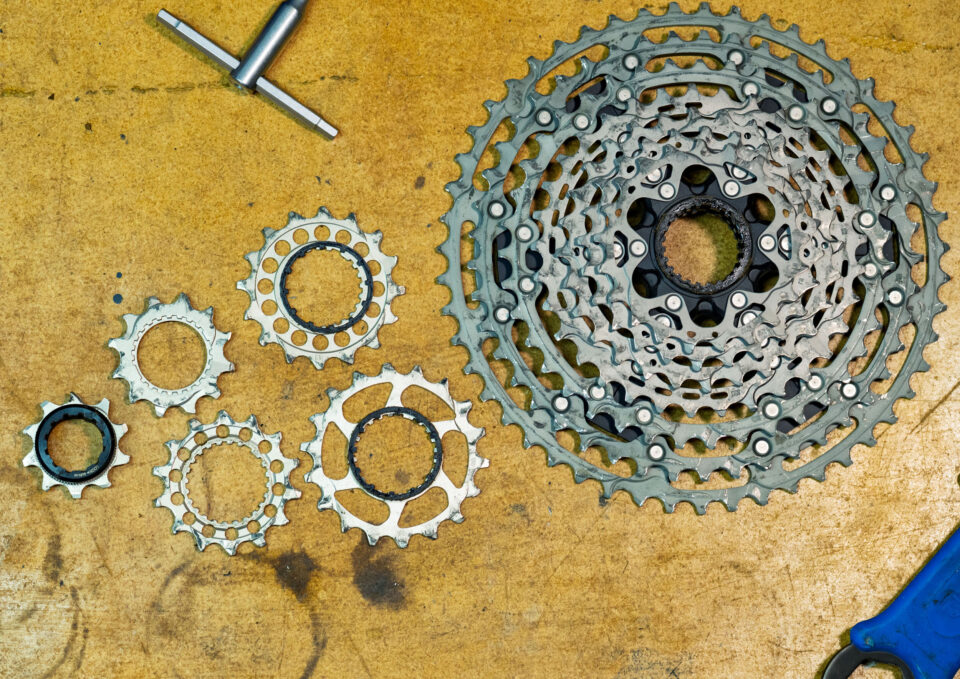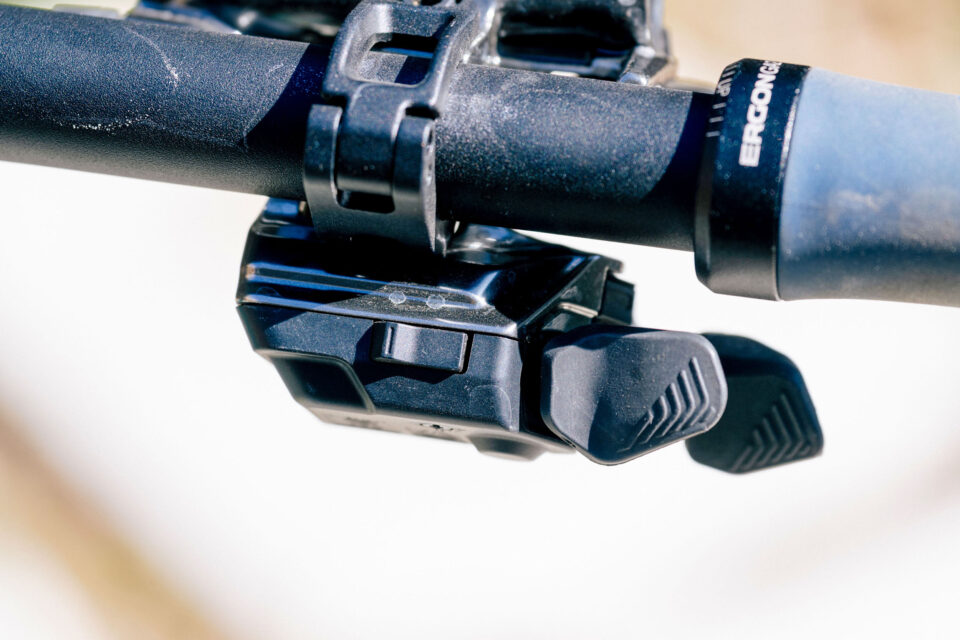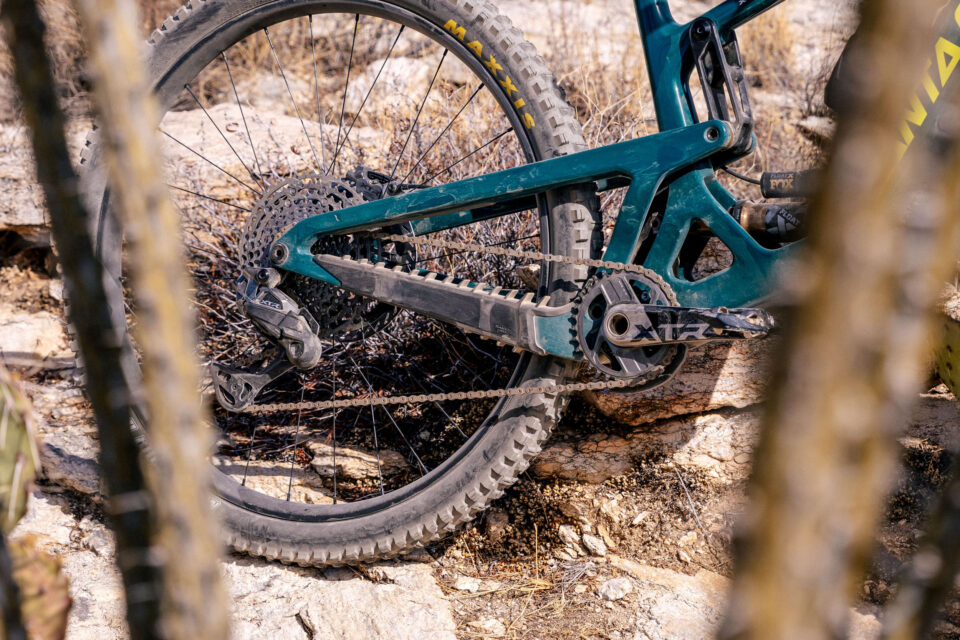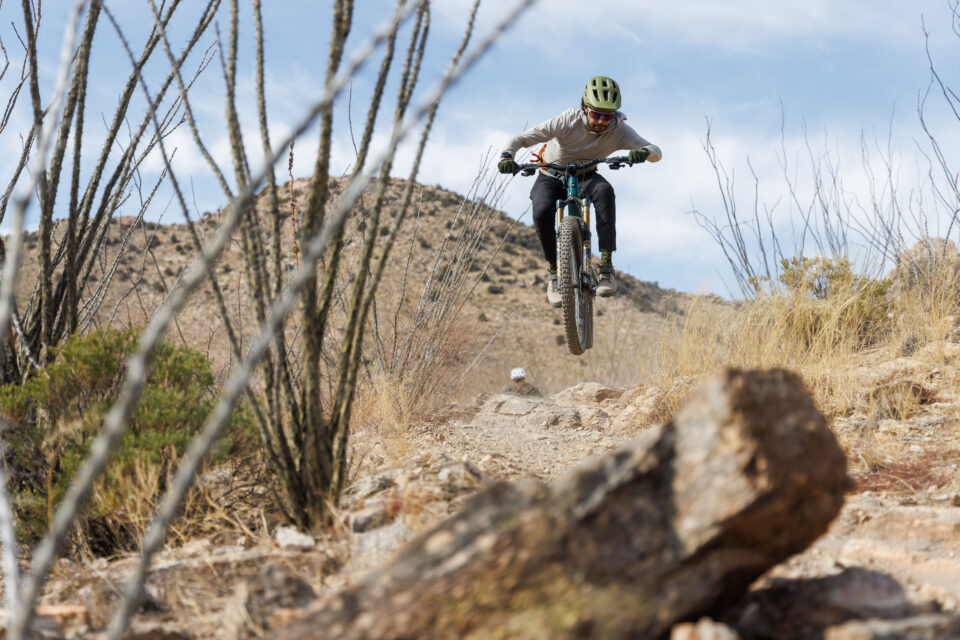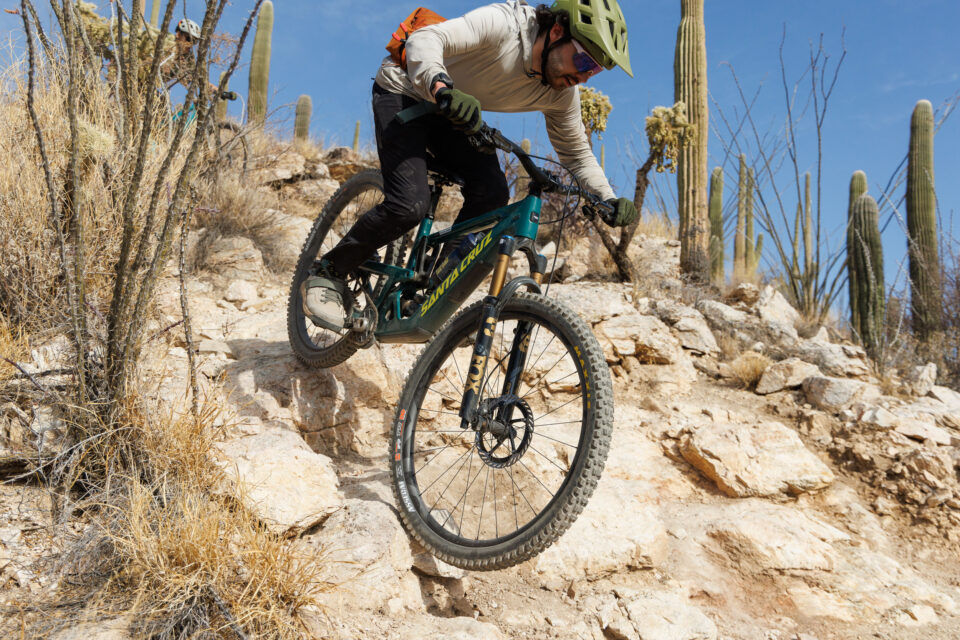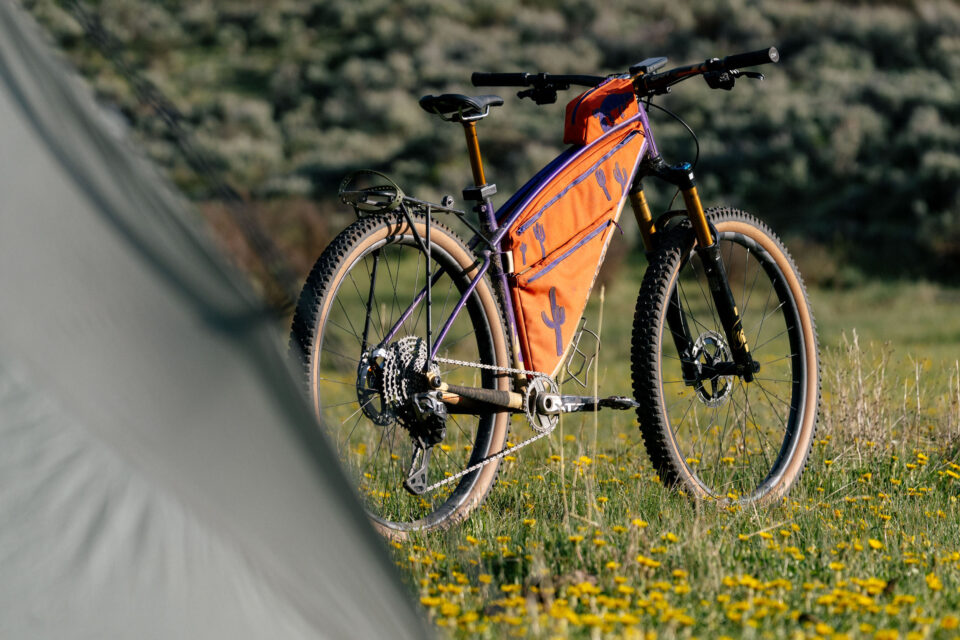Shimano XTR Di2 Review: Shimano Finally Goes Wireless
It was a long time coming, but Shimano finally launched their fully wireless XTR drivetrain. Was it worth the wait? To find out, we real-world tested the Shimano XTR Di2 wireless system on trail rides and bikepacking trips over the last few months for this full review, complete with actual weights and prices compared to other drivetrains…
PUBLISHED Jun 4, 2025
Shimano’s long-awaited wireless mountain bike drivetrain is finally here. After years of anticipation, the new Shimano XTR Di2 has gone fully wireless, and we’ve been putting it through its paces to see if it lives up to the hype. From rugged singletrack rides to loaded bikepacking getaways, we’ve spent months testing the system in real-world conditions. In this full review, we dig into how it performs, how it stacks up against the competition, and whether it was truly worth the wait. Watch below, then scroll down for the full written version with photos and other details, including actual weights, pricing, and comparisons with SRAM and mechanical drivetrains.
Before we dig into the new goods, it’s worth briefly revisiting Shimano’s history and what was behind XTR. The company was founded in 1921 by Shozaburo Shimano in Sakai City, Japan, and began by manufacturing bicycle freewheels. Over the following decades, Shimano expanded into a full range of drivetrain components, quickly earning a reputation for precision engineering and forward-thinking innovation. By the 1970s, they’d introduced Dura-Ace for road bikes and Deore for mountain bikes, cementing their place in both disciplines. As mountain biking boomed in the ’80s and ’90s, Shimano was at the forefront, developing components tailored to the sport’s evolving demands. And while most know them for their contributions to cycling, Shimano is also a major force in the fishing industry and has even ventured into snowboarding gear and footwear, showcasing their diverse capabilities.
Focusing on bikes—and specifically XTR—Shimano introduced this high-performance mountain bike group in 1991. Meant to be the MTB counterpart to Dura-Ace, the original M900 series was lightweight, precise, and premium, featuring an 8-speed setup with rim brakes. Over the years, each generation has pushed the envelope: the addition of disc brakes and external bottom brackets in the early 2000s, Shadow Plus clutch tech during the 10-speed era, and later Di2 integration and 12-speed gearing with the M9100 series. XTR has consistently served as Shimano’s innovation platform for cutting-edge mountain bike technology.
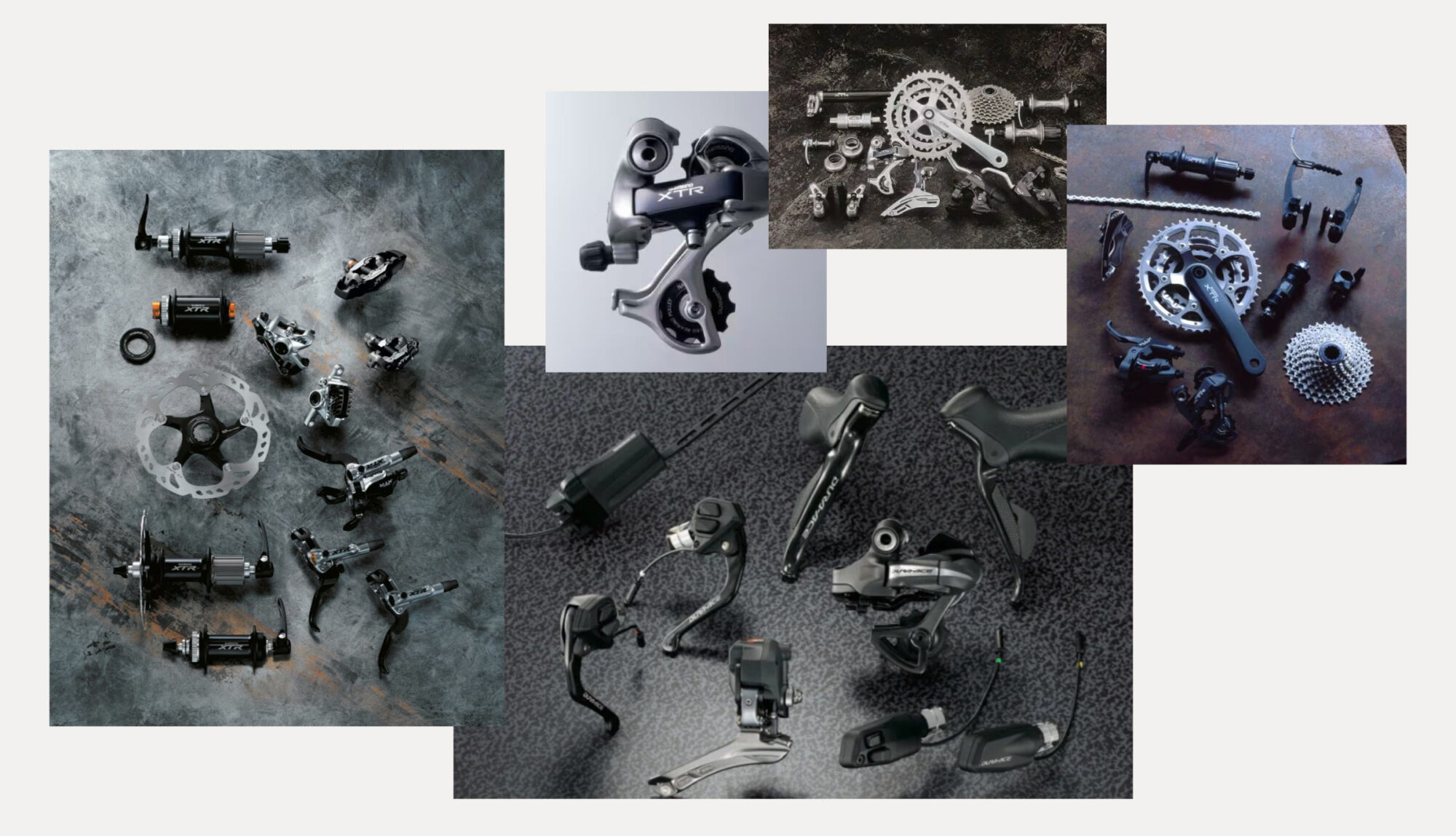
As for Di2—short for Digital Integrated Intelligence—Shimano launched its first electronic drivetrain in 2009 with the Dura-Ace Di2 7970, a 10-speed, fully wired system that made waves in the road scene. After testing it with pro teams, the company brought Di2 to the Ultegra level, making it more accessible, and then to mountain biking with the debut of XTR Di2 in 2014. Di2 has evolved significantly since then, moving to wireless shifters, 12-speed cassettes, and ditching junction boxes. In 2024, Shimano extended its latest Di2 tech to gravel with the updated GRX Di2 group, delivering cleaner cable-free setups, faster shifting, and improved ergonomics—further proof that Di2 continues to shape the future of drivetrain performance.
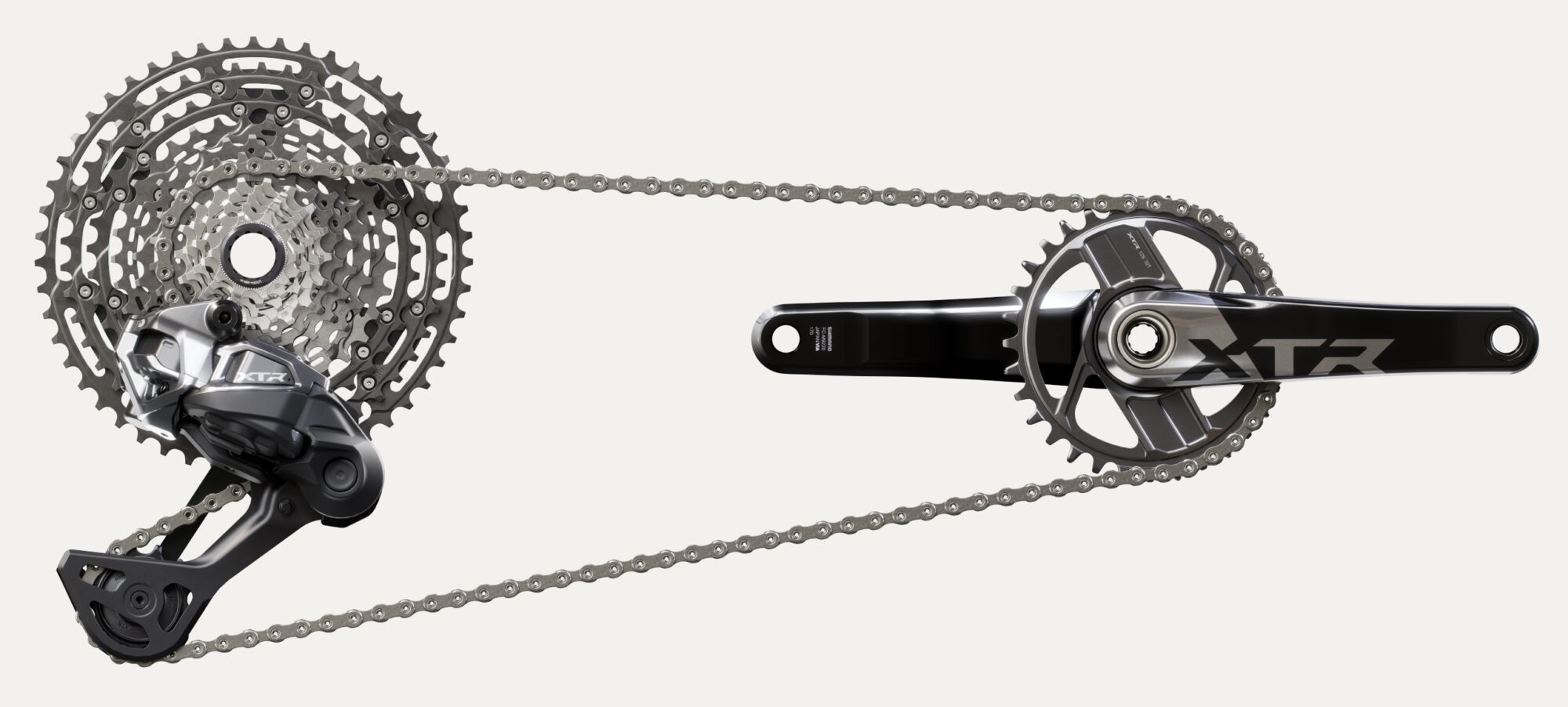
What’s New
There were undoubtedly some issues with the previous Di2 system—namely that it required wires, and the installation process wasn’t exactly intuitive—and even understanding how it all worked could be confusing. With their semi-wireless setups, Shimano eventually made things easier, but there were still lingering problems—especially with mountain bike derailleurs. The clutch wasn’t technically flawed, but it often went unserviced, even though it was designed with regular maintenance intervals. I even made a video on how to repair and maintain a Shimano derailleur clutch because it was such a prevalent issue. In fact, I still have a few XT derailleurs sitting around collecting dust because of neglected clutch maintenance.
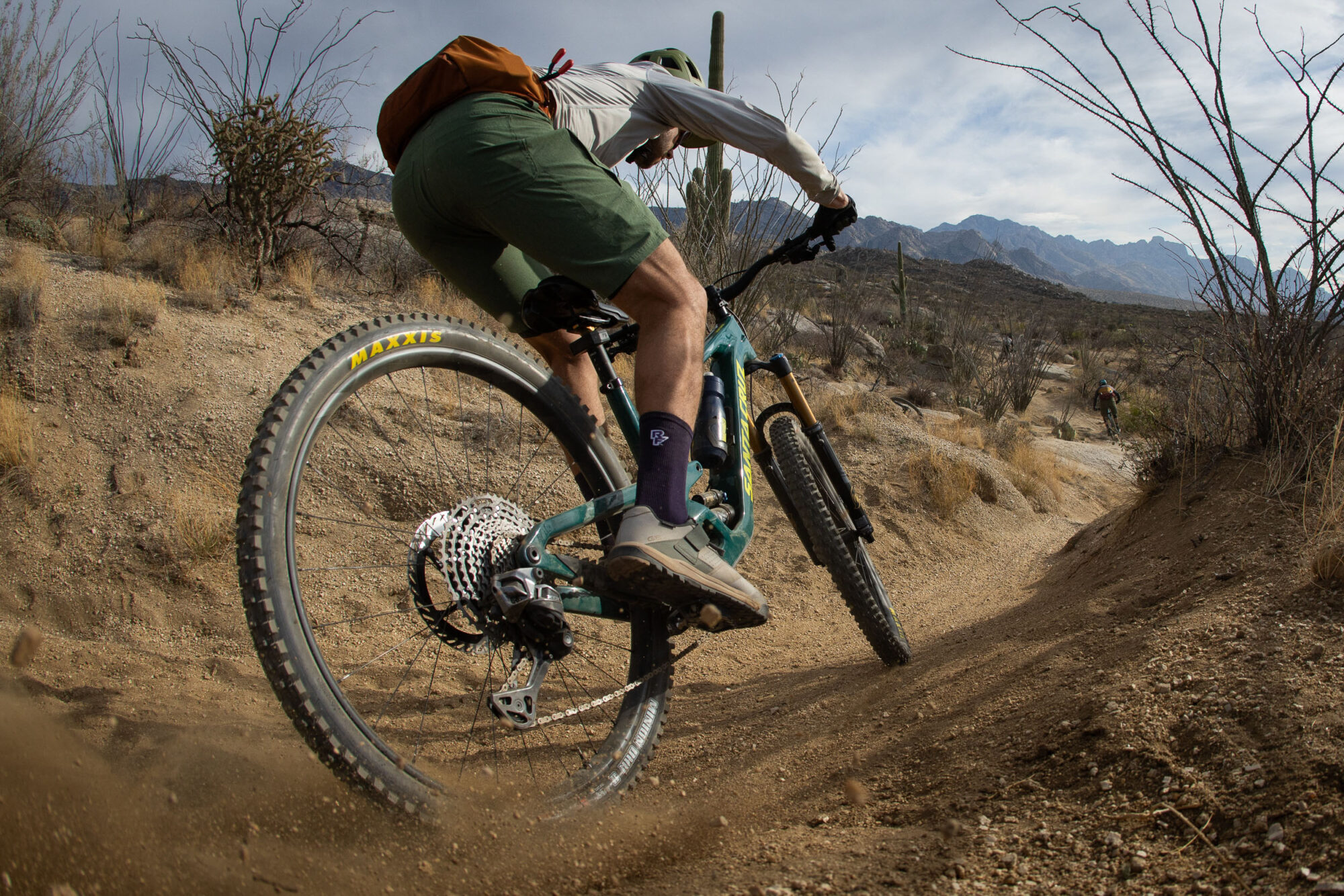
With the new M9250 XTR rear derailleur, Shimano set out to fix existing pain points and finally make the system fully wireless. Building something like this from the ground up isn’t easy, especially when you also have to navigate existing patents in the industry. Specifically, locating a non-infringing battery placement on the derailleur and not mounting the derailleur directly on the frame. And that, according to Shimano, was a challenge, but they managed, and here we are.
Shimano XTR Di2 Derailleur (RD-M9250)
You might be asking: does the new Shimano wireless XTR derailleur use a hanger or is it direct mount? The short answer is that it uses the exact same mounting procedure as other Shimano derailleurs. The new Di2 XTR is fully backward compatible with Shimano’s existing ecosystem, meaning it works with current XTR, XT, SLX, and Deore parts with Hyperglide+. No proprietary chain, chainring, cassette, or even frame. Just a new wireless derailleur and shifter is all you need. You can run it on a modern bike or a frame from the ’80s, as long as it has a derailleur hanger.
Regarding compatibility with existing Di2 drop-bar systems, the XTR Di2 Derailleurs are fully compatible with some existing drop bar systems, including DuraAce 12spd Di2, Ultegra 12spd Di2, 105 12spd Di2, and GRX 12spd Di2—basically, everything that is already semi-wireless Di2. It’s kind of like SRAM AXS back in 2019 but also very different in execution.
Shimano’s choice to stick with the hanger was intentional—they genuinely believe it’s the better design. Plus, they like the updated strength of modern hangers but still very much appreciate a fail point that is rather inexpensive and easy to fix. One of Shimano’s goals with this derailleur was to make it with a relatively low profile, starting with a slim skid plate to reduce frontal surface area. From there, they shaped the rest of the derailleur around it.

The result is a new dual-spring chain stabilizer that increases spring tension, improves chain wrap, and eliminates the need to service a clutch altogether. However, we still don’t have a cage lock (similar to SRAM) or the ability to insert an Allen key to lock the Vivo derailleur cage open. I would love to see something like this from Shimano. That said, it shifts really fast and feels solid. Just to compare: the derailleur body on SRAM Transmission sticks out significantly more than the new XTR M9250.
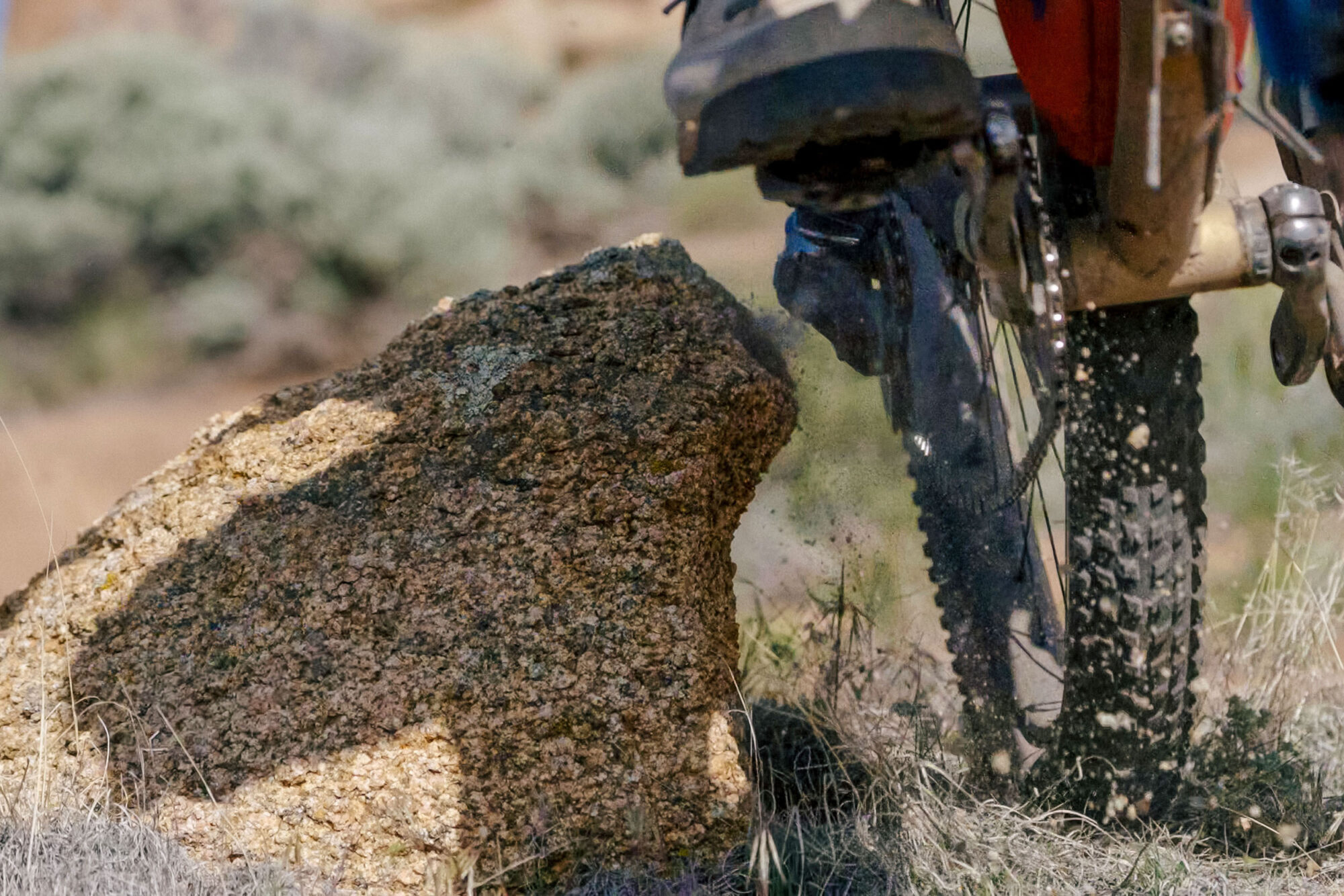
Shimano wanted a system that could shrug off trail impacts—whether it’s trail debris or a surprise rock strike. And while I tried very hard to smack the derailleur, it was tough to actually make it happen, especially on slower singletrack where the derailleur sits more inboard. I managed a few times, and it was quite exciting. It’s designed to get knocked, and when you hit the resin bumper or skid plate, the derailleur motor kicks in, recovers the gear, and returns to the correct cog before you even notice. It’s hard to trigger that kind of impact deliberately, but you can see how fast it reboots just by hitting it. The other thing is that the derailleur moves freely backward, something Shimano mentions is an important part of impact recovery. Plus, if you wear down the bumper or most of the parts on this derailleur, they are replaceable.

One of the more noticeable upgrades is how much faster the shifting feels. Shimano says the improved chain wrap and increased tension help here, and I’d agree—the cog-to-cog engagement is crisp and snappy. Combined with their existing Hyperglide+ tech in the cassette and chain, the whole system feels incredibly smooth. And that’s even before we discuss the new shifter, which I’ll get into shortly.
Now, about the battery. It’s tucked away behind the new stabilizer and skid plate, secured by a spring-loaded cover that locks it in place. I found out the hard way that the battery won’t stay put without that cover, so keep that cover on. Accessing the battery is probably my biggest gripe. It’s not exactly intuitive or convenient, especially when things get dusty or grimy. SRAM’s latch system is cleaner in that regard. That said, once installed, Shimano’s battery is fully protected and well hidden. You might not even guess where it is when you see it for the first time.
Behind the battery are the motor and main electronics, and up top, you’ll find traditional limit screws and B-tension adjustment screws for those who still appreciate the classic setup process. The pulley cage is full carbon and feels much sturdier than the past mechanical XTR derailleur. It also does a good job of shielding the pulley wheels, which are now solid, meaning no more picking out twigs or trail junk mid-ride.

All in all, this derailleur is a big leap from the current mechanical version—larger, certainly heavier, but much more robust. And if Shimano’s history of trickle-down tells us anything, I wouldn’t be surprised to see a similar design show up in their mechanical line sooner rather than later, but as of today, only XT, Deore, Cues, and GRX mechanical will carry forward.
Shimano XTR Cassettes (CS-M9200-12)
While we’re back here, let’s briefly go over the cassette. The new XTR cassette sees a few changes, but as I mentioned, it’s fully compatible with the previous XTR drivetrain. And really, the changes aren’t massive. It’s still available in two sizes, but the 10–45 option is now a 9–45. That gets paired with Shimano’s new short cage XTR derailleur, which gives the system about 23mm more ground clearance between the cage and the trail. Shimano noted that most World Cup pro racers are opting for the 45T version cassettes now, and going with the 9-tooth cog makes it that much more versatile. A new lockring and lockring tool was necessary to make the 9-tooth on existing MicroSpline drivers possible, which is interesting,

There’s also been a slight refinement to the tooth profiles. The first update is a tougher (and not black finish) coating on the two larger aluminum cogs to keep the cassette looking nice for longer and more uniform. And some of the teeth have a bit more material at the base, making them thicker and more durable. Lastly, there was an updated rivet structure to eliminate the potential for creaking. These are subtle changes, as the system is fully compatible with the R9100 cassette.
Shimano XTR Di2 Shifter Switch
Let’s get to the little thing that tells everything else what to do: Shimano’s new “Shift Switch,” which is powered by two stacked 1632 batteries and might be the highlight of the entire system. At first glance, the shifter looks a lot like a traditional one. Sure, there are some obvious differences, but it’s not a thumb paddle like SRAM’s setup. It’s a modern-looking shifter with a classic touch, and once you feel it, you will fall in love—or at least I did; it’s super unique.
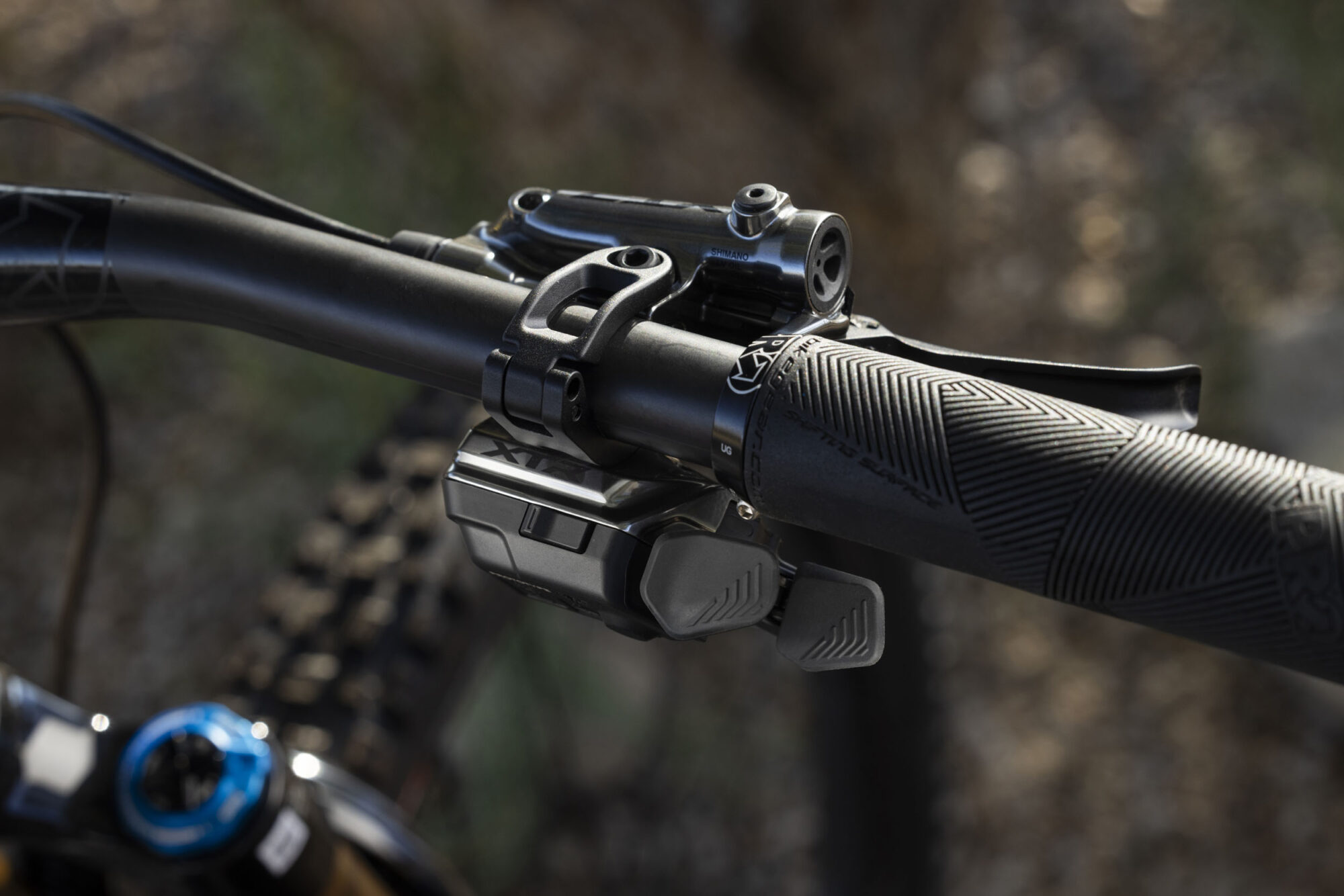
It features two buttons with a solid, tactile feel and tons of adjustability. Each paddle can be repositioned by loosening a super accessible 3mm bolt. That gives you the option to rotate the paddles up or down or angle them more inboard or outboard. When paired with I-SPEC EV (or just a standard clamp), you can slide the entire unit closer to or farther from the grip. It’s the most customizable shifter I’ve used, hands down.
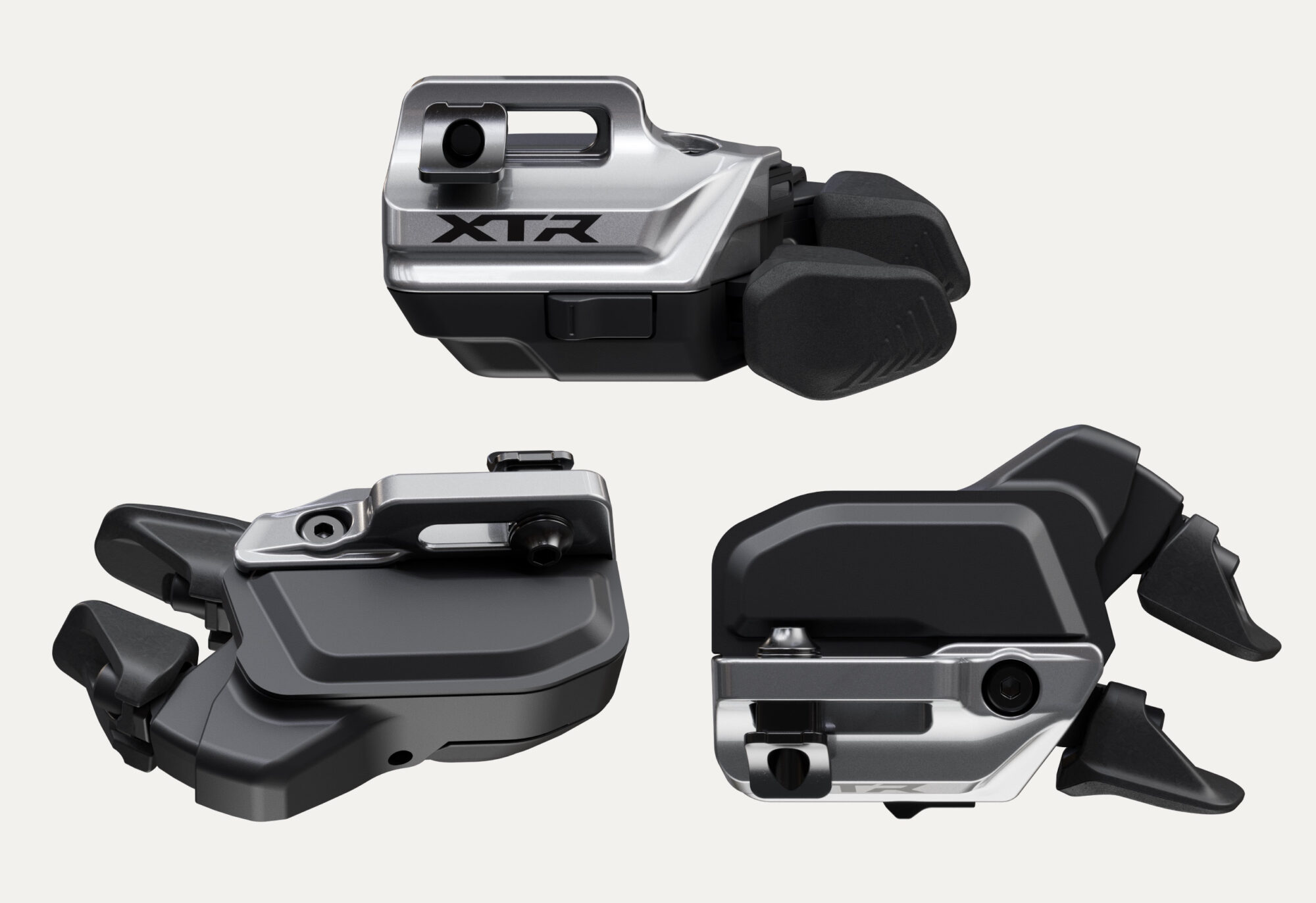
Now, maybe the coolest feature: each paddle gives you a single shift with a tap, or you can hold it down for rapid shifting. You can even adjust the shift speed through the E-Tube app. But the real magic is the small flathead dial underneath the shifter, which lets you enable double-shift mode. Basically, this mimics the double-press feel of a mechanical shifter. Push beyond the initial click, and it shifts again. Hold it down, and it keeps going into multi-shift mode. It does take a bit of pressure to trigger that second click, but it feels great and keeps a bit of that mechanical sensation alive. My biggest gripe? No two-way shifting. It’s one of my favorite Shimano features, and I’m hoping they find a way to bring that back in a future update.
Finally, there is another little button on the front; this is a simple way to trim the shifting on the go. All you need to do is hold it for two seconds, and you are in trim mode. The derailleur can move 18 steps inward and 18 steps outward from the initial position, for a total of 36 positions, allowing you to fine-tune if you bend your hanger or if you swap the derailleur from bike to bike and a slight change is needed. You can also access this function by pressing and holding the function button on the derailleur itself for two seconds and making adjustments on the shifter after that. Once you are done, hold it down again or hold the shifter button down for two seconds, and you are ready to shift again.
Shimano XTR Cranksets (M9200)
The new XTR Crank is also very similar to the previous version. Shimano feels like the industry is returning to metal cranks, and they never left, so they are happy continuing their hollow-forged cranks with their HOLLOWTECH II construction. These cranks go through a series of precise forging steps. The result is a metal crank that is strong and light, and the new XTR crank comes within 10 grams of their previous XC crank but is said to be even stronger.
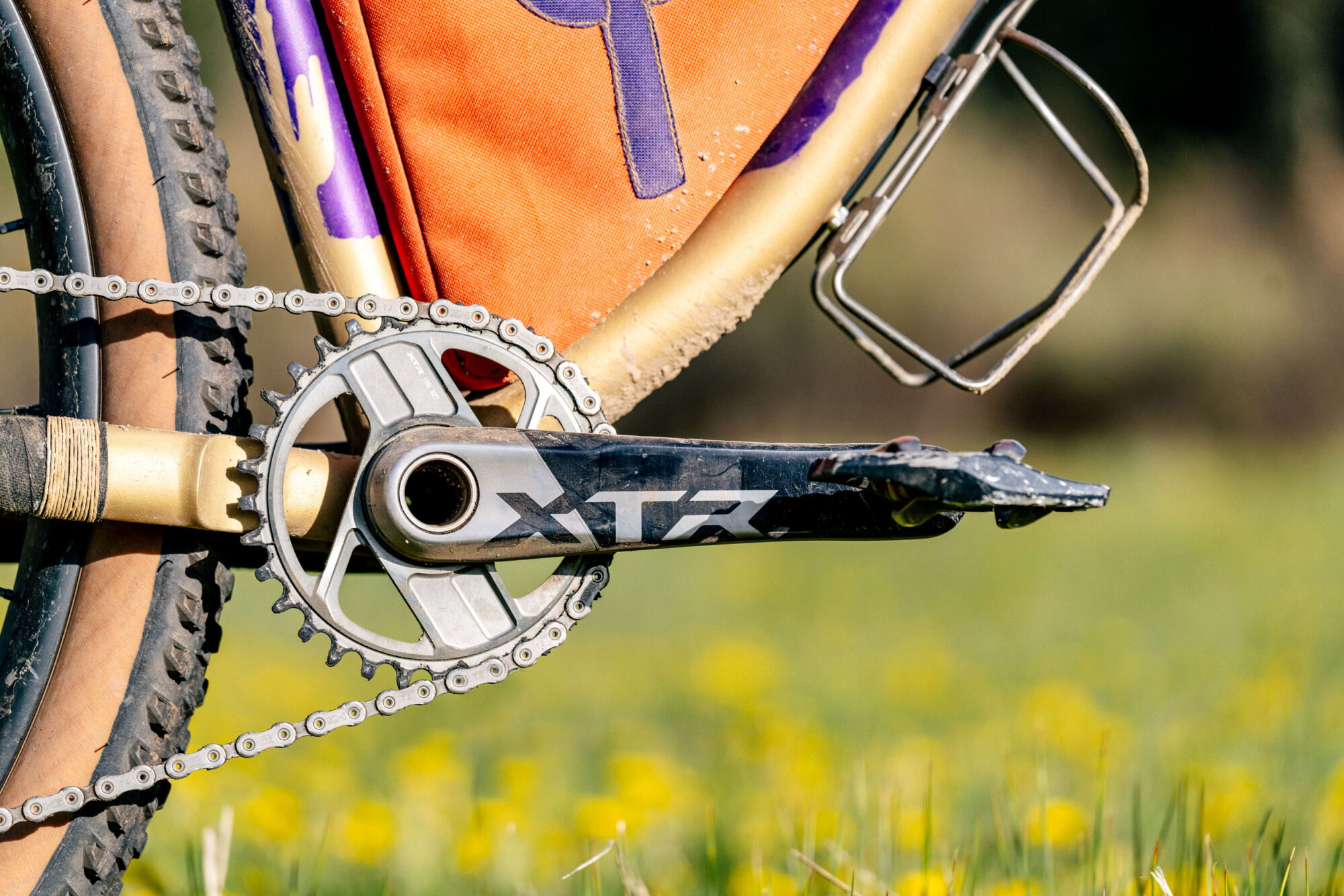
They’re offering two versions: one for XC and one for Enduro. The main difference lies in the spindle stiffness and Q-factor—168mm for XC and 176mm for the Enduro version. Crank arm lengths are also discipline-specific, with the Enduro model offering a 160mm option.
There’s just one chainline option, which is now at 55mm. That said, the previous chainrings had a -3mm offset, and the new ones have a 0mm offset. An old ring installed on a new crank will give a 52mm chain line. New chainrings installed on old cranks will move the chain line out by 3mm. Shimano will have more details on this, but they mention you should avoid a 56.5 or 58mm chainline.

The new chainring sizes range from 28 to 38 teeth, and you can choose the exact size you want, as the crank will not come with a chainring. The chainring itself has also been slightly updated and reinforced in areas prone to rock strikes. There is no new bottom bracket with the same BB spacing standards, and as mentioned, the system is fully compatible with the current Hyperglide+ chains.
Pricing and Actual Weights
Before we go any further, here are the weights and pricing. I weighed all the parts myself—these are used but relatively clean. The XTR long cage derailleur comes in at 414 grams, which is heavier than the 375-gram XX AXS but lighter than the 450-gram XX AXS Transmission. It’s also significantly heavier than the previous long cage XTR Di2 (E-Tube) at 295 grams and more than the 240-gram mechanical XTR derailleur. For reference, the battery makes up 22 grams of that total weight. The new XTR cassette comes in at 364 grams, which is right in line with the current 367-gram version. The new shifter is a bit bulkier, weighing 101 grams. The crankset without a chainring comes in at 531 grams, and the 32T chainring adds another 65 grams.
| Group | XT | XTR | GX AXS | GX T2 | X0 T2 | X01 AXS | XTR Di2 |
|---|---|---|---|---|---|---|---|
| Derailleur | 282g | 240g | 452g | 489g | 470g | 390g | 414g |
| Shifter | 135g | 112g | 80g | 70g | 48g | 82g | 101g |
| Crankset | 645g | 595g | 635g | 734g | 623g | 471g | 596g |
| Cassette | 473g | 367g | 453g | 446g | 381g | 354g | 364g |
| Chain | 252g | 242g | 244g | 284g | 262g | 260g | 242g |
| Totals | 1787g | 1556g | 1874g | 2023g | 1784g | 1557g | 1717g |
As for pricing, the upgrade kit, which includes the new derailleur, shifter, battery, charger, and a quick link, comes in at a hefty $985 USD. The derailleur alone is priced at $665, the shifter at $220, the battery at $55, and the charger at $45. Essentially, you get a free quick link when buying the full kit. The crank, whether you go with the XC or Enduro version, is $310, and the two new cassettes are priced at $500. All chainrings are sold at $150. It’s far from cheap, but XTR has never been about affordability.
| Group | GX AXS | GX T2 | X0 T2 | X01 AXS | XTR Di2 |
|---|---|---|---|---|---|
| Derailleur | $390 | $400 | $550 | $538 | $665 |
| Shifter | $150 | $150 | $150 | $229 | $220 |
| Crankset | $199 | $200 | $300 | $377 | $460 |
| Cassette | $231 | $250 | $400 | $415 | $500 |
| Chain | $36 | $50 | $100 | $64 | $85 |
| Totals | $1006 | $1050 | $1500 | $1623 | $1930 |
Battery life and Charging
Let’s talk battery specifics. Shimano claims around 200 miles per charge, though that’ll obviously vary based on terrain and riding style. The battery itself is 305mAh, rated to work from 14°F to 122°F, and it’s small enough to stash in a repair kit if you’re heading out on a longer trip and want to pack an extra. For most weekend-plus outings, one battery should hold up just fine.
When the battery starts getting low, the system gives you some warning. I did run into this but forgot to see how long it took to get to this point, unfortunately. First, multi-shift automatically turns off. Then shifting slows way down—like, one shift every four seconds slow—and it sometimes hesitates when trying to move up the cassette. I also noticed that once the battery is critically low, the derailleur won’t connect to the app via Bluetooth anymore, presumably to save power. I’m not exactly sure how long you’ve got once it enters that slow-shift mode, but I’m sure we’ll all figure that out with more use.
As far as visual indicators go:
- Solid green = 100–51%
- Flashing green = 50–26%
- Solid red = 25–1%
You can also get a good idea of battery life by pairing it with the E-Tube app.
The battery uses a proprietary charger and comes with its own USB-C cable, which Shimano recommends using. Like the old Shimano chargers, it glows yellow while charging and simply turns off when fully charged. If you don’t want to carry a spare battery, bringing the charger along is a solid backup. It’s pretty compact.
One last thing to note: the system goes to sleep after a set amount of time not shifting to conserve battery. That means if you’re transporting the bike, the system won’t slowly drain like some SRAM setups have been known to do. To wake it back up, just tap the shifter a handful of times, and you will eventually hear it shift.
The Shimano E-Tube App
The E-Tube app is your primary way to communicate with the derailleur, so it’s more important than ever. Thankfully, it’s easy to set up, and once you do the initial pairing, each time you want to sync your phone with the derailleur, you just have to hold the function button on the derailleur until it turns blue, release it, then open the E-Tube app, and it will automatically pair.
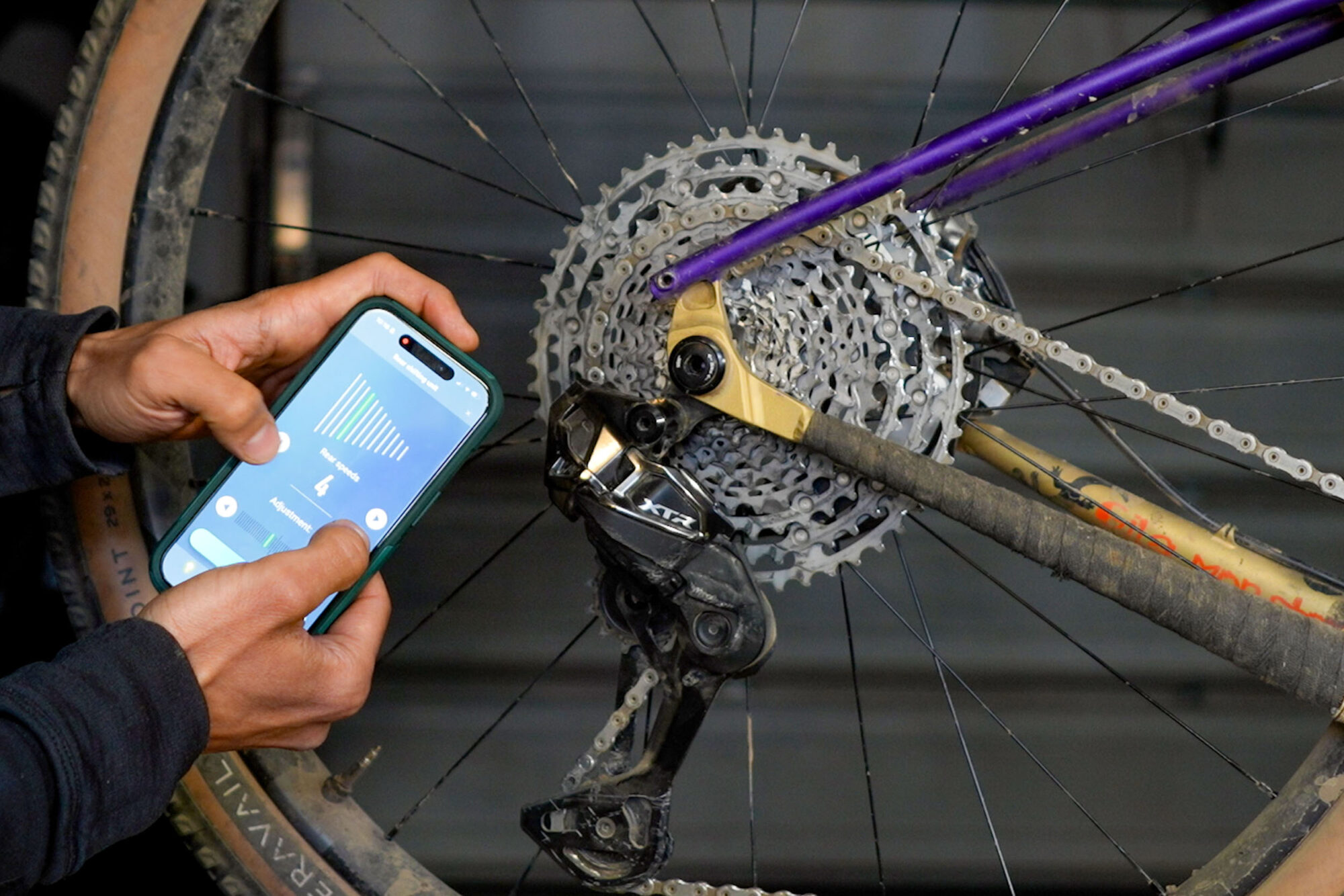

Once connected, the app has three straightforward pages:
- The Update page lets you wirelessly install firmware updates.
- The Customize Page gives you control over your shifting setup. You can dial in multi-shift functionality (enable it for both first and second-level shifting, adjust how fast it shifts, and set how many gears it moves at once). This section also lets you pair an additional switch. So, if you wanted to run Di2 drop-bar levers with the rear derailleur, you can do that here.
- And then, the Maintenance page, which shows your battery status, gear usage, error log, and shifting adjustment. This is also where you can trim the derailleur without using the shifter, and you can also shift the derailleur here. If your shifter dies on you or you break it, you can still shift using your phone. That said, the option to shift on the derailleur itself is not currently available.
On the Trail (Performance)
I was fortunate to test the new XTR system on and off over the past few months. I first jumped on it when Shimano invited us down to Tucson, Arizona, to rip some super fun trails with their crew and check out the new bits and bobs. My first ride was on a Santa Cruz Hightower built up more for enduro or trail riding, something Shimano truly created this system for. I wouldn’t mind seeing a 9-51 someday, but for now, the 510% range is more than enough for my riding. And if I need to fine-tune things, I just do it at the chainring.

We rode 50 Year Trail and the Lemmon Drop with the La Milagrosa add-on, chasing some Shimano skunk team riders and employees, which was a hoot. I don’t think I’ve ever tested a product that hard and fast right out of the gate, especially on a bike I’d never ridden before.
My first takeaway? The shifting. It was sharp, fast, and handled all the slow-speed tech where you need to dump gears in a hurry to prep for the next move. Shimano mechanical has always been solid in that department, but this was next level. With second-level shifting enabled, it’s easily the fastest and smoothest shifting I’ve ever experienced—and it feels totally effortless. Yes, the wireless system plays a big part, but the chain and cassette have to keep up, too, and the new chain stabilizer really seems to prevent skipping and keep everything tight—especially when paired with their already well-engineered Hyperglide+ tech.
Speaking of, the new stabilizer also replaces the old clutch-style system. I used to have to turn the clutch off if it was broken or too stiff, which sometimes led to loud, messy descents. But with this setup, I never felt like the chain was going anywhere it wasn’t supposed to.
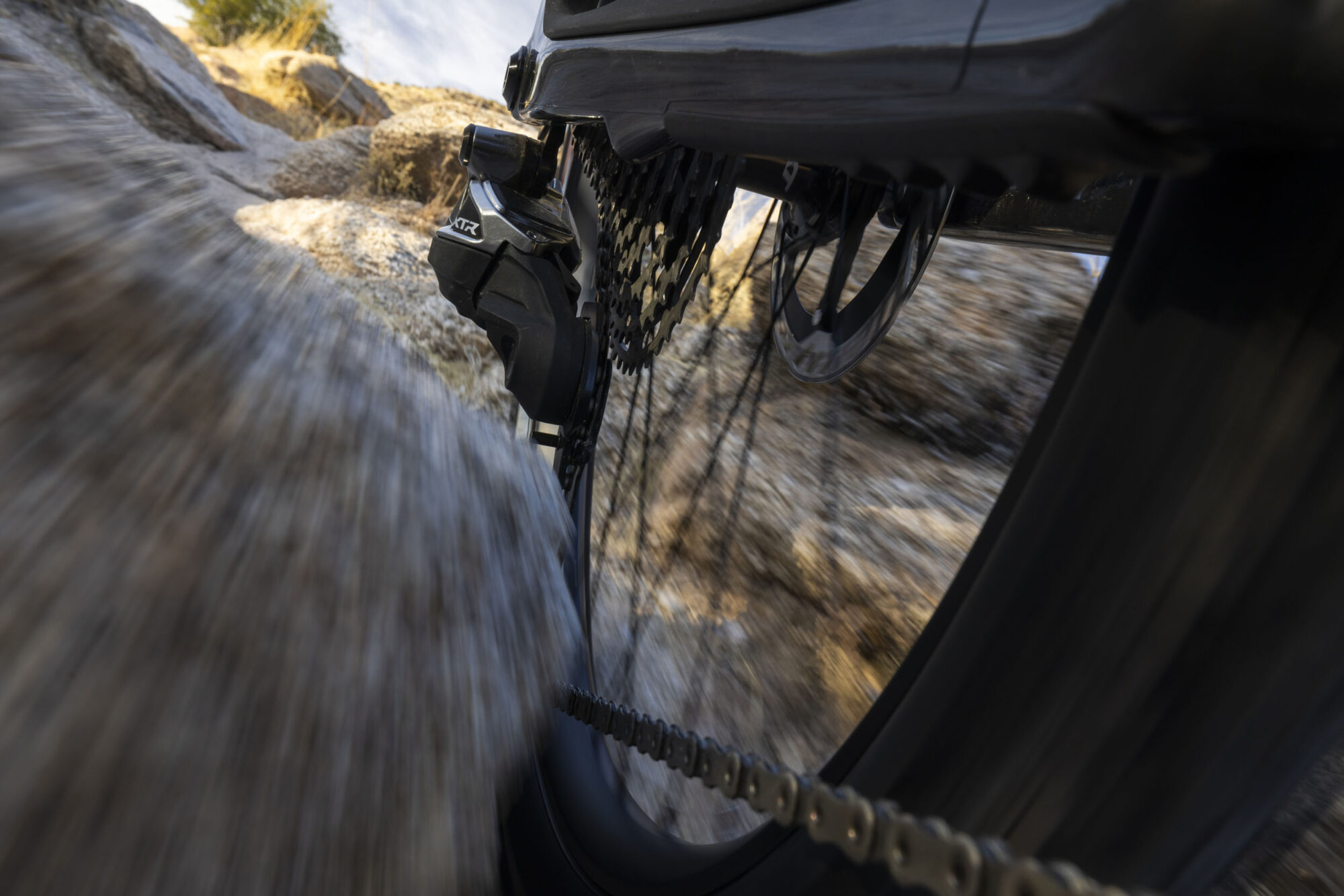
I tried pretty hard to smash the derailleur on rocks. I hit a few things on purpose and came away without any major consequences, with the body and cage brushing off those impacts without issue. The low-profile design really seems to help here. I don’t recall hitting the derailleur unintentionally on all of my other rides.
One downside I did notice was how often I was striking the cranks. That’s probably more about crank length than anything. I was running 170mm and could’ve gone with 165s on the Hightower. Either way, the metal cranks took a beating, and it shows.
All told, I put a bunch of miles on the Hightower over the past few months and only had one weird issue: the chain randomly jumped into the spokes once. I couldn’t replicate it and didn’t replace the hanger or even adjust anything, so I chalk it up to a freak incident. Still, it’s worth mentioning.
Bikepacking
Naturally, I had to take this group bikepacking. So, I swapped all the new bits Shimano launched today—the XTR derailleur, shifter, brakes, and wheels—over to my custom Goodday Curiosity Gila Monster, my go-to bikepacking rig. One of the biggest perks of wireless is how easy it is to install and uninstall. Once everything was swapped over, all it took was a quick trim adjustment through the shifter and a check on the B-tension, and I was ready to roll. Oh, I did have to cut the chain to length, making sure the derailleur had the five or six extra links plus a quick link, as recommnded in the technical documentation.
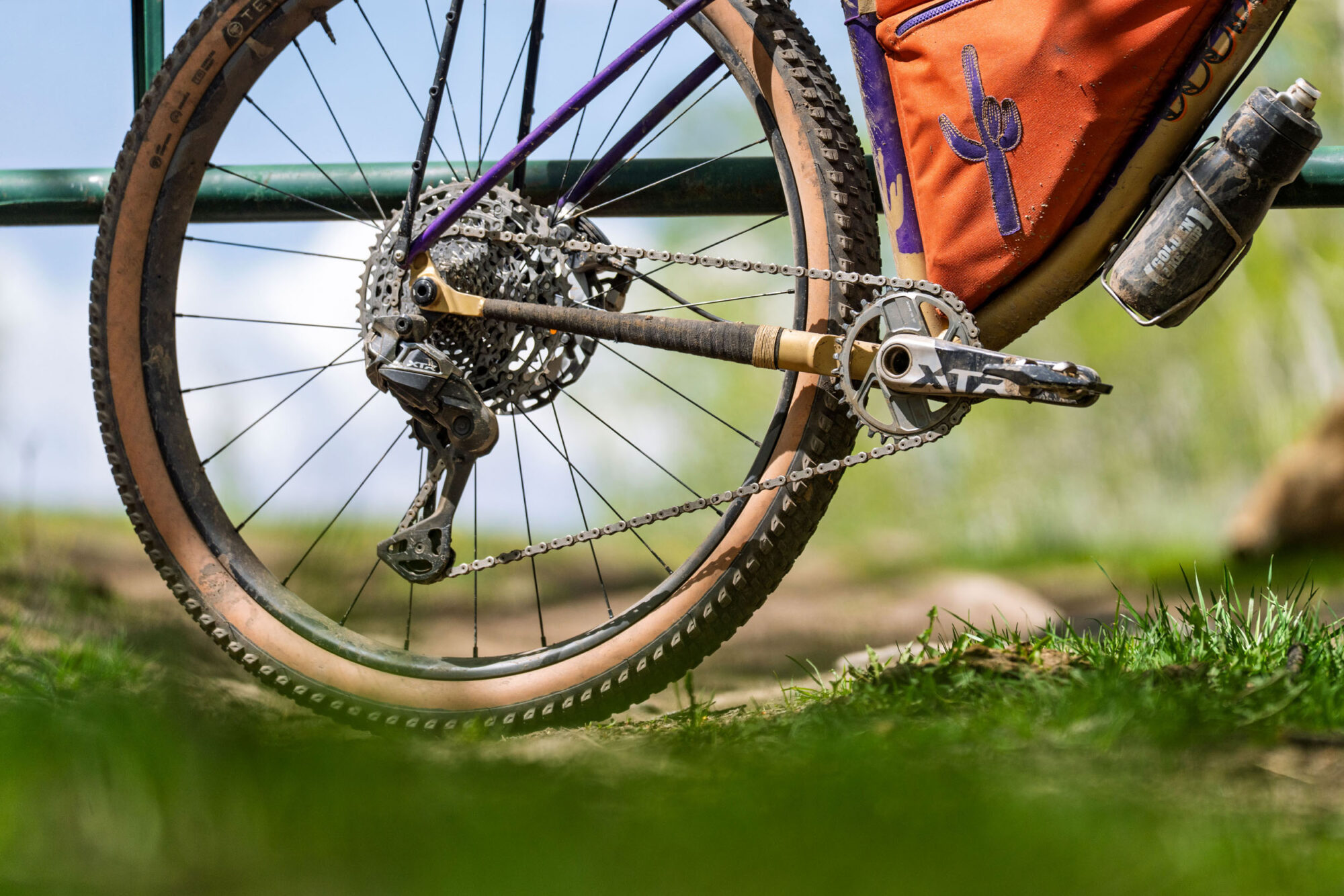
Bikepacking has a way of exposing annoyances that might not show up on shorter rides. It’s a great way to log serious hours—even days—on a system, which is why I like testing gear this way. I rode through dust, snow, mud, and river crossings over a few trips with the new XTR, and the system never blinked. I had been running SRAM XX Transmission on this same bike, and the XTR felt noticeably smoother. Not all bikes are created equal, and in my experience, Transmission works best on frames that are “on the list,” whereas a traditional derailleur setup can usually be dialed in with a couple of limit screws and a B-tension tweak. That said, I didn’t even have to touch those after the swap, but just knowing I could makes me feel better when I’m deep in the backcountry.
- Model Tested: Shimano XTR Di2 Review
- Actual Weight: 1,717 grams
- Place of Manufacture: Japan
- Complete Price: $2,030
- Upgrade Kit Price: $985
- Manufacturer’s Details: Shimano
Pros
- Wicked-fast shifting
- Backward compatible with continued use of Hyperglyde+
- Shifter is a bit of engineering genius
- Low-profile design proved challenging to hit
- Damage-resistant design
- Doesn’t depend on a specific hanger type
- Battery is small and easy to pack
- Easy-to-use trim functionality
- App is very straightforward
Cons
- Battery placement is not intuitive
- Cage clutch or cage lock would have been nice
- XTR prices
- No way to shift on the derailleur
- Would have love to see Fox and Shimano team up to make universal battery
- No two-way shift (trigger style) on Shift Switch
Final thoughts
I don’t think I’m surprising anyone by saying the updates to the derailleur are a welcome sight. I’ve always loved Shimano shifting—it’s typically crisper and faster than SRAM—at least until the clutch wears out, and I either have to service it or realize it’s already too far gone and rusted out. But with these fixes and the long-awaited move to a fully wireless system, it feels like a big step forward. Pair that with a unique and highly adjustable shifter and some of the fastest shifting I’ve ever experienced, and it’s a pretty exciting package. The fact that it’s backward compatible—and that upgrade kits are an option—is also refreshing.
Shimano has always leaned into broad usability, from CUES all the way up to XTR. And while this new system isn’t exactly budget-friendly, and the idea of that much mass hanging off a relatively small hanger still makes me a little uneasy, it’s held up so far, even after trying to break it on purpose.
Overall, it’s great to see real competition in the drivetrain space again, and I’m glad to hear the patent hurdles are likely behind them. If history’s any guide, we’ll probably see a trickle-down across the lineup that brings this tech to more accessible price points. As for XTR, this is the most robust version I’ve ever seen, and with its shifting capabilities, it might end up being more popular than I expected. Plus, the chrome/silver continues on, and the overall shape is relatively easy on the eyes.
What do you all think? Are you into the new wireless system from Shimano? Let us know your opinions in the conversation below!
Please keep the conversation civil, constructive, and inclusive, or your comment will be removed.


